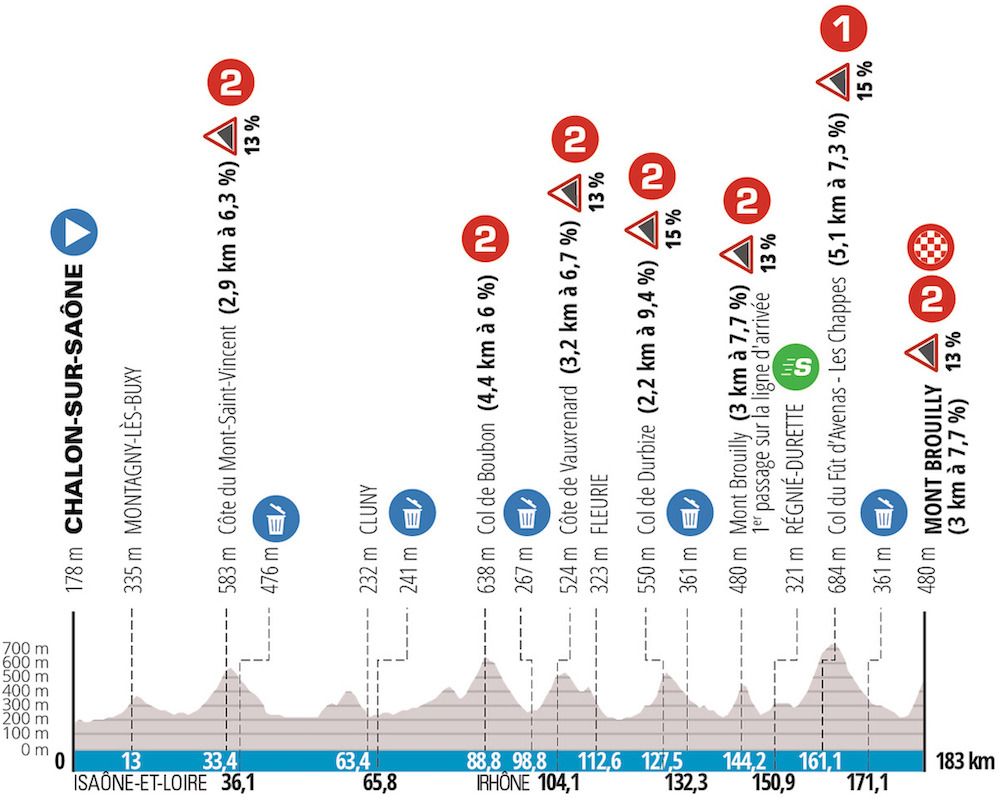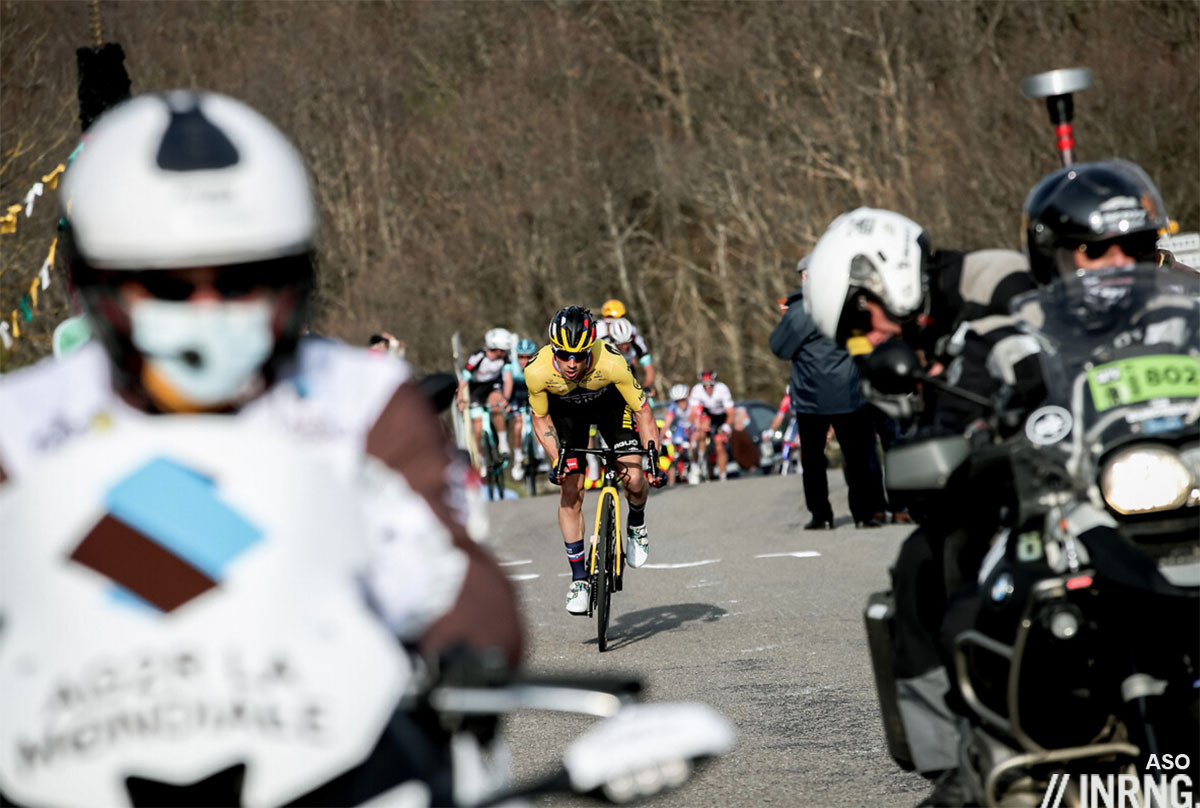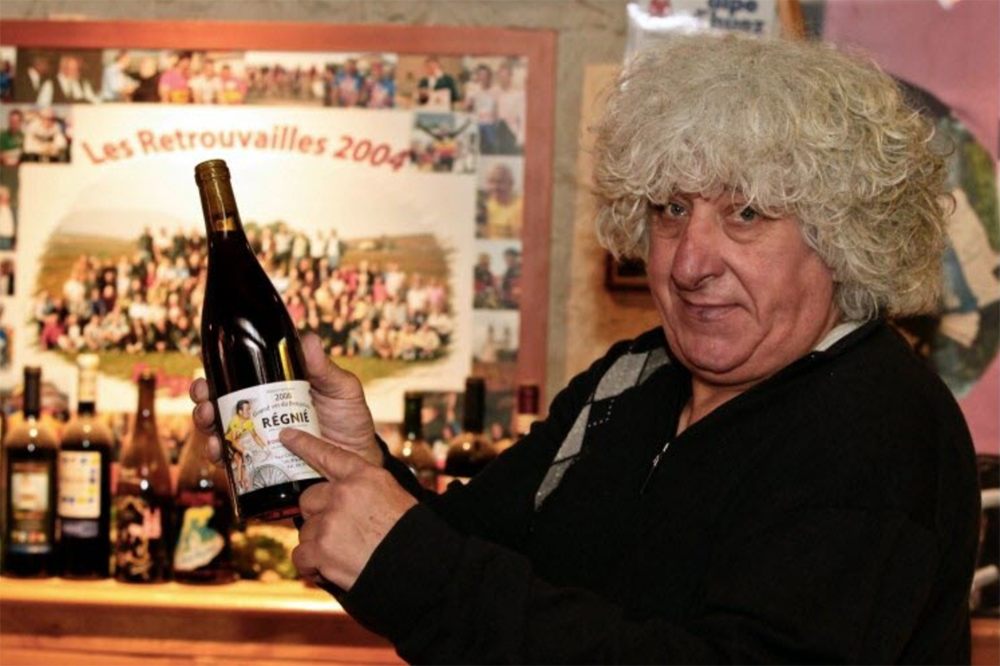 A mountain stage of sorts, today’s route has some unexpected surprises in store.
A mountain stage of sorts, today’s route has some unexpected surprises in store.

Les beaux temps et la pluie: the win for UAE which put Brandon McNulty in yellow and Jay Vine, Finn Fisher-Black and João Almeida at the top of the GC, 15 seconds ahead of Jayco’s Chris Harper and Luke Plapp, 18 seconds ahead of Remco Evenepoel, 20 on Egan Bernal. Losers of the day were Bora-hansgrohe, 54 seconds down, a lot in a race often decided by small margins. Lidl-Trek also had a bad day at work, 17th at 1m15s.
It was instructive as a lesson in team cohesion and form but the results were affected by a sudden downpour and hailstorm and all this came and went with blasts of wind. Soudal, Bora and Visma were among those who got a soaking, and found the tailwind enjoyed by others had faded. Remco Evenepoel and co were fastest to the intermediate point but would finish fourth, Bora second but finished eleventh. Tactics counted too, Bora for example burned through their riders such that were just three left for the run back to Auxerre. Our duel between Evenepoel and Roglič is, for now, a story of UAE having several contenders ahead of them.
It was good to watch. A team time trial is often hard to enjoy, a row of riders in formation but with teams able to shed riders you could see more of what was happening as riders cracked under pressure from their own team mates. Also FranceTV was also using a drone – apparently a first for a World Tour race – and being able to do travelling shots close to the riders helped show the speed, let’s hope the experiment is validated for the Tour de France.

The Route: 183km and 3,300m of vertical gain. The first climb of Mont-Saint-Vincent’s too early to do damage but it’s a tricky climb on a narrow road, a sister climb to the Signal d’Uchon and then its onwards across Burgundy to the medieval town of Cluny. The Col de Boubon is a long, gentle climb and the road keeps climbing to the unmarked but oddly named Col de la Sibérie, as in Siberia. This marks the crossing point into the wine-making region and from here on the stage gets spicier.
There’s a loop to take in the Col de Durbize with 2km at 10% amid the vineyards and then the descent and the passage over the Mont Brouilly to pass the finish line. Brouilly, or the Montée de la Chapelle is one of those climbs whose profile never does it justice, it is not a difficult climb because of the slope but because of the slopes, plural. It is constantly changing gradient, and it twists and turns and so it’s awkward to ride.
The Col du Fût d’Avenas is a long climb and it’s featured before in Paris-Nice (Primoz Roglič won just below the pass when it was branded “Chiroubles”), the Dauphiné and Tour. But this time it’s tackled via a new route, the main road for the first third and then left turn onto some small farm roads that climb up directly through the vineyards and then into woodland. It’s narrow here and steep in places with a kilometre featuring 10-12%. The King of the Mountains point doesn’t mark the end of the climbing, it drags upwards for 3km before the descent proper begins.

The Finish: Mont Brouilly again. The two profiles are the same climb but from past visits of Paris-Nice and serve to show how the graphic depiction can suggest different things. The left image just doesn’t capture the difficulty of the climb, the one on the right tries but also hypes things up, there’s no 25% and the climb doesn’t reach 500m either.

The Contenders: a very hilly day, a steep uphill finish and normally Primož Roglič (Bora-hansgrohe) would be invincible here but he’s not the easy pick he would have been a year ago or even the start of the week but we’ll see how he responds, part of yesterday’s problem was that he and team mate Aleksandr Vlasov were too strong for their team mates.
Mont Brouilly is the anti-time triallists climb, it keeps changing slope but Remco Evenepoel (Soudal-Quickstep) has won Liège-Bastogne-Liège, today’s course is similar and he can bully the final climb, plus he seemed to be smarting after yesterday’s loss.
UAE are now out to defend the race lead. A few years back João Almeida was a very punchy, aggressive rider before becoming the archetypal diesel on long climbs, happy to sit back when others stand up on the pedals. But he can do short climbs like this while Brandon McNulty is looking very lively right now and Finn Fisher-Black is very punchy and can make a move that might not be closed down right away.
Among the others, Matteo Jorgenson (Visma) can do steep climbs but a win would be a surprise. Mathias Skjelmose (Lidl-Trek) seems strong but not in peak form. Bahrain have options with Pello Bilbao and Santiago Buitrago. Ineos too have options but a win for Carlos Rodriguez and Egan Bernal might be more of a surprise.
Can a breakaway survive? There’s the mountain points to go and get anyway. It’s not easy for the breakaway the big teams will want to get to work and so they’ll set a fierce pace for the second half of the stage. Contenders who are far enough down on GC,and could climb to the win are Anthon Charmig (Astana), Pierre Latour (Total Energies), Jason Osborne and Luca Vergalitto (Alpecin-Deceuninck) but Charmig could stay to help his leader Tejada and we’ll see with Latour if he’s resolved his descending phobia.
| Evenepoel | |
| Roglič, Vlasov, McNulty | |
| Fisher-Black, Bilbao, Jorgenson |
Weather: weak sunshine and 9°C with a light NW breeze, no more than 15km/h by the final.
TV: France3 for locals and VPN users, it’s on Eurosport too and likely to be on the same channel you watch the Tour de France. Coverage begins around 3.10pm CET with the finish forecast for 4.35pm CET.

Postcard from Régnié-Durette: Fleurie, Brouilly, Régnié… today’s stage finish reads like a wine menu as it passes some famous Beaujolais vineyards. Among the winemakers here is Paul Cinquin, a pioneer who introduced thermovinification – briefly warming up the pressed grapes on their arrival in the winery to help extract more from them – to the Beaujolais and has fronted Beaujolais nouveau promotions. Instantly recognisable thanks to his mop of hair he’s also a massive cycling fan whose wine cellar was long a cycling shrine, decorated with yellow, pink and rainbow jerseys, all dedicated to him. A good amateur who wanted to turn pro but it didn’t happen and he went into the family business of wine but kept up his passion for cycling. Cyclists started to drop by and bartered, a yellow jersey for a case of wine but above all this wasn’t transactional, it was friendship. Cinquin, Paulo to his friends soon had many pals in the peloton.

In 1984, confronted with a friend Paul Gutty who became paraplegic, he started organising Les Retrouvailles (“the reunion”), a celebrity criterium featuring retired riders as a fundraiser. Spectators could see Hinault, Gimondi, Poulidor, Kelly, Darrigade, Motta, De Vlaeminck, Roche, Bahamontes and Fignon “racing” together on roads amid the vines. Those names cited in the previous sentence aren’t the stars over the years who attended, they’re just some of the starters from the 1994 Retrouvailles. The 1996 edition had 149 ex-pros whose careers ranged from the 1940s to the 1990s. The event has stopped now but he’s enjoyed a special role connecting old champions with contemporary ones and even ventured into diplomacy: he even claims the long feud between Eddy Merckx and Freddy Maertens was ended when the two came together over a glass of wine chez Cinquin.

A worthy effort by Jayco … Matthews included.
The teams seem more susceptible to falling apart under these rules.
They did very well. I saw the first time check and they were, at the time, only second to UAE but had four riders. They did well together, Matthews, Harper, Plapp and Durbridge with “Durbo” dropping off by the finish.
I think this team used to be better at TTT. Traditionally Australia cycling funding is about the track and many upcoming riders trained a lot in individual and TTT for the track. Why because the commonwealth games and the Olympics have lots of track medals so it gets the funding. Olympic and to a lesser degree commonwealth games being close to the only important metric for amateur sports funding in the country by the goverment.
These days Aust cyclists on the road are less likely to come from the track programme so its a dying art.
Enjoyed yesterday’s stage, really liking the way teams had to deal with the climbing. Ouch for Rog but he bounces back today.
The Retrouvailles sounds like it should be organised again today. You get retired footballers and tennis players doing these exhibition tournaments, so why not a masters criterium?
I think the Retrouvailles still exists actually, but it’s been renamed « Gravel Racing »
So much of the organisation seems to be related to Cinquin’s energy and his winery while those tennis exhibition events probably attract ex-players because of, frankly, the appearance fees. But whether it’s a pro event or a gathering in a winery it’s probably a good idea.
It’s quite common for today’s riders not to know much about Eddy Merckx and the rest. We can use “today” widely, ask Del Toro but we’ve heard variations of “Eddy who?” from Peter Sagan, Edvald Boasson Hagen and Laurent Fignon among others. Cycling’s media often evokes history, (“the third rider after Merckx and Gimondi to win Race ABC” etc) but the participants are not as interested, normal. But Cinquin really helped, several active pros at the time said they got a lot out of meeting the older riders and realised just how similar they all were, rather than old guys from black and white photos.
Great piece about Cinquin, I didn’t knew anything about it and it’s a story well worth being remebered.
As for athletes and the history of their sport, Van der Poel (for obvious reasons, maybe ^__^) is often keen to drop some reference to the past, be it on the road or in CX. Contador never hid his interest for cyclists of previous generations, either, especially about Pantani or Bahamontes, and while the latter may easily feel logical, in Pantani’s case he did so well before agiography started again, and before apologetic thoughts began to be due. Pantani himself kept contacts with Gimondi. Aru, Bernal are other athletes who come to mind as they on some occasions expressed an interest in the past of the sport, even without having been directly asked. Gilbert was quite aware of the historical perspective, too. However, many cyclists remember the idols whose poster they had on the wall, hence those from 10-15 years before, but few delve deeper into the past. And, of course, several aren’t interested at all beyond the current state of competition.
+1
Bradley Wiggins has an encyclopaedic knowledge of the history of the sport, always worth listening to.
I wish Eurosport would put Wiggo back on the moto. Few of the current guys are worth listening to.
I wonder if it was the same before. For example, was Eddy interested in Bobet, Bahamontès, Coppi or Bartali when he was a rider ? Did he know much about them ? Did Binda know about Garin or Petit-Breton ? Etc. I think, like gabriele is saying, there has always been some riders interested and other not at all. Maybe riders from new cycling countries, for obvious reasons, are generally less interested and know less about cycling history : if your father was a rider or a fan you know it better. And it might also depend on the age of the cyclist : at 35, after being asked so much questions by journalists, you may know better (and be more interested) than when you arrive at 20 and all you want to do is win everything and be the greatest.
Thanks Inner Ring. A master piece and a master wine too. Long time ago (1993) was there and meet the gay
I have a feeling Peter the great’s “Eddy who” was more a piss taking than actual ignorance.
Thank you, yet another very interesting preview. Small correction: I believe Bora didn’t finish tenth, but eleventh.
Fixed thanks. Any person who did a match bet for Cofidis to beat Bora is currently browsing sports car websites.
Fascinating stuff. Thanks so much for the nostalgic postcards!
The drone footage was fantastic! I hope we see a lot more of this in future (but maybe keep the helicopter sound effect for old times sake)
as others have said, thanks for the piece on Cinquin – lovely stuff and knew nothing about this. So much to enjoy about your writing on this blog and the knowledge of many of those below the line. Been following along for years with the occasional comment and this is one of the brightest lights on the web for me. Thanks.